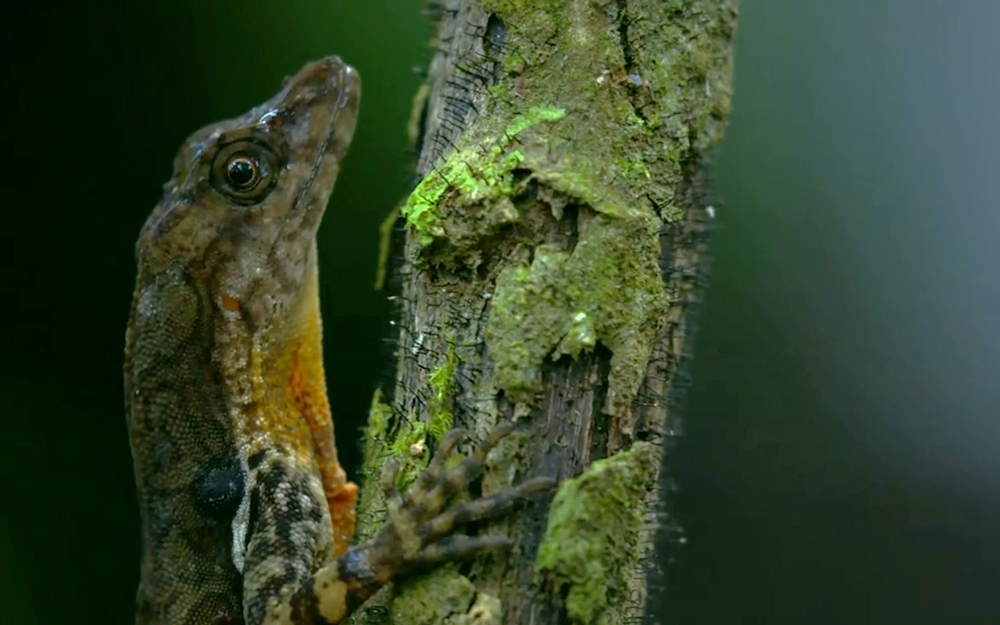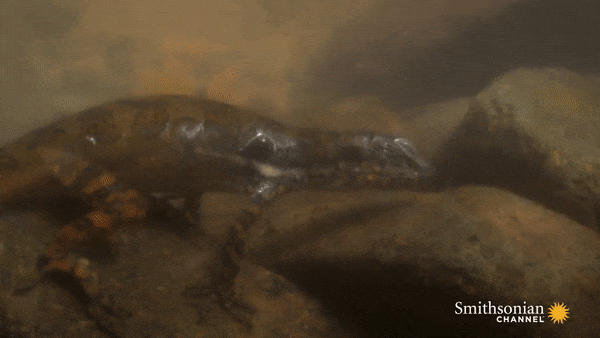WATCH: First-Ever Footage of a Lizard Breathing Underwater

Lizards can't breathe underwater — or can they?
Footage of a river anole that was recently filmed in Costa Rica revealed that the species — Anolis oxylophus — possesses a highly unusual ability. The anoles breathe stored oxygen while underwater, something that has never been seen or documented before in lizards.
Biologists and filmmakers Neil Losin and Nate Dappen caught this remarkable behavior while shooting the anole-centric documentary "Laws of the Lizard" for the Smithsonian Channel. Costa Rican river anoles were known for disappearing underwater for minutes at a time, but scientists thought that the elusive reptiles were just very good at holding their breath. However, the truth turned out to be far stranger, as Losin and Dappen found a previously unknown behavior in the group. [Images: Exotic Lizards Pop Out of the Ground in Florida]
For more than a year, the filmmakers traveled to locations around the world to film "Laws of the Lizard," which tells the surprisingly complex story of anoles, a lizard group found across the American tropics. Anoles are small and colorful, and they are equally at home across a diverse range of habitats, from rainforests to suburban backyards.
Though these lizards may seem common and uninteresting, scientists are fascinated by the creatures, publishing thousands of studies on anoles over the past 50 years, Losin told Live Science. And because anoles are so well-researched, they present scientists with the chance to ask highly nuanced questions about anoles' evolution, biology and behavior, Dappen explained.
One of those deep-diving questions was about the diving Costa Rican river anole and what exactly was happening after they jumped into the water, remaining there for as long as 15 minutes. Herpetologist Luke Mahler, an assistant professor of ecology and evolutionary biology at the University of Toronto, urged the filmmakers to look closely at their underwater footage when they filmed the anoles, to see if they could identify any clues that would explain what the river anoles were doing.
While Dappen and Losin didn't see anything out of the ordinary when they first reviewed the video, they watched it more closely after they returned to the United States. That was when they noticed something remarkable.
Sign up for the Live Science daily newsletter now
Get the world’s most fascinating discoveries delivered straight to your inbox.
"We saw this re-breathing behavior that hadn't been documented or described before," Losin said.

What they observed was astounding. As a submerged female anole crouched on the river bottom for nearly 10 minutes, a tiny bubble repeatedly expanded and contracted at the top of her head. The lizard appeared to be recycling her air, much as a human diver would draw on oxygen from a tank.
Presumably, re-breathing stored air would enable river anoles to remain underwater long enough for them to outwait threats on land, Dappen explained. Drawing on air caches is known to occur in some invertebrates, such as diving bell spiders and diving beetles, but this may be the only example of re-breathing in land animals that have backbones, Losin said.
How the river anoles accomplish this feat is still uncertain, but Mahler and his colleagues are currently investigating the mechanics of the behavior, Losin told Live Science.
"It demonstrates one of the things that biologists often find, which is that there's so much we don't know about nature," Dappen said.
By showcasing this anole species — and its numerous cousins across the Americas — "Laws of the Lizards" may help viewers finally understand why scientists think these lizards are so special.
"I would love for people to come away from the film seeing that even the most seemingly mundane creatures in their backyards can be fonts of scientific knowledge — if someone just takes the time to look," Losin said.
"Laws of the Lizard" airs Dec. 26 at 8 p.m. (local time) on the Smithsonian Channel.
- Photos: Gorgeous Shots of the Adorable Horned Lizard
- Album: Bizarre Frogs, Lizards and Salamanders
- Image Gallery: Acrobatic Tricks of Lizards & Robots
Original article on Live Science.

Mindy Weisberger is an editor at Scholastic and a former Live Science channel editor and senior writer. She has reported on general science, covering climate change, paleontology, biology and space. Mindy studied film at Columbia University; prior to Live Science she produced, wrote and directed media for the American Museum of Natural History in New York City. Her videos about dinosaurs, astrophysics, biodiversity and evolution appear in museums and science centers worldwide, earning awards such as the CINE Golden Eagle and the Communicator Award of Excellence. Her writing has also appeared in Scientific American, The Washington Post and How It Works Magazine. Her book "Rise of the Zombie Bugs: The Surprising Science of Parasitic Mind Control" will be published in spring 2025 by Johns Hopkins University Press.









